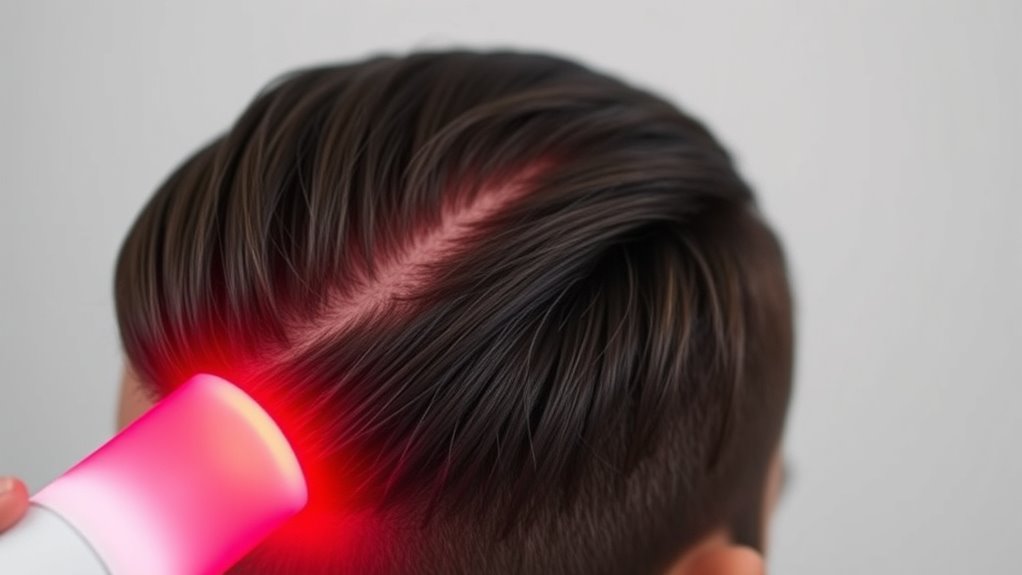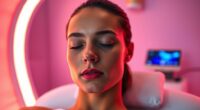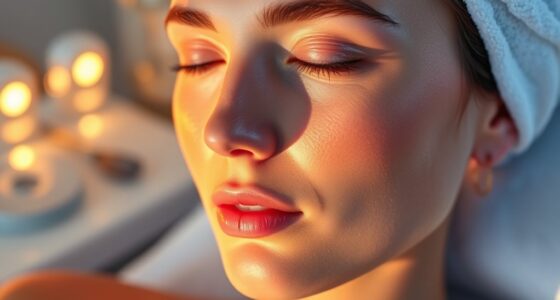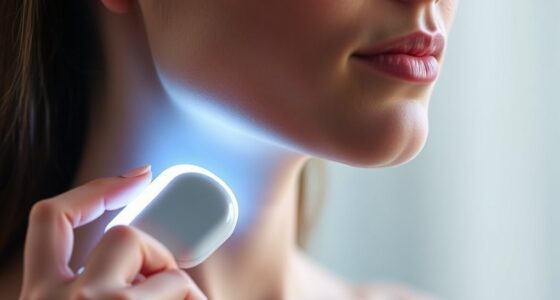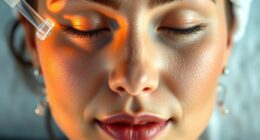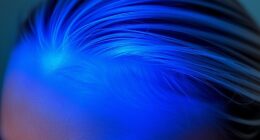Light therapy uses specific wavelengths of red or near-infrared light to stimulate your hair follicles, increasing blood flow and boosting cellular activity. This process helps revitalize dormant follicles and promotes healthier hair growth. Studies show that consistent use can improve scalp health and counteract factors like genetics, stress, or hormonal imbalances. If you want to discover how new research highlights its benefits and practical applications, keep exploring further.
Key Takeaways
- Recent studies confirm that specific wavelengths of light stimulate hair follicle activity and promote healthier hair growth.
- Light therapy increases scalp blood circulation, enhancing nutrient and oxygen delivery to dormant or weakened follicles.
- Scientific evidence shows that consistent light treatment can reverse hair loss by revitalizing follicle stem cells.
- New research highlights the effectiveness of combining light therapy with other treatments like topical medications for better results.
- Advances in laser technology improve treatment precision and efficacy, making light therapy a viable, non-invasive option for hair regrowth.
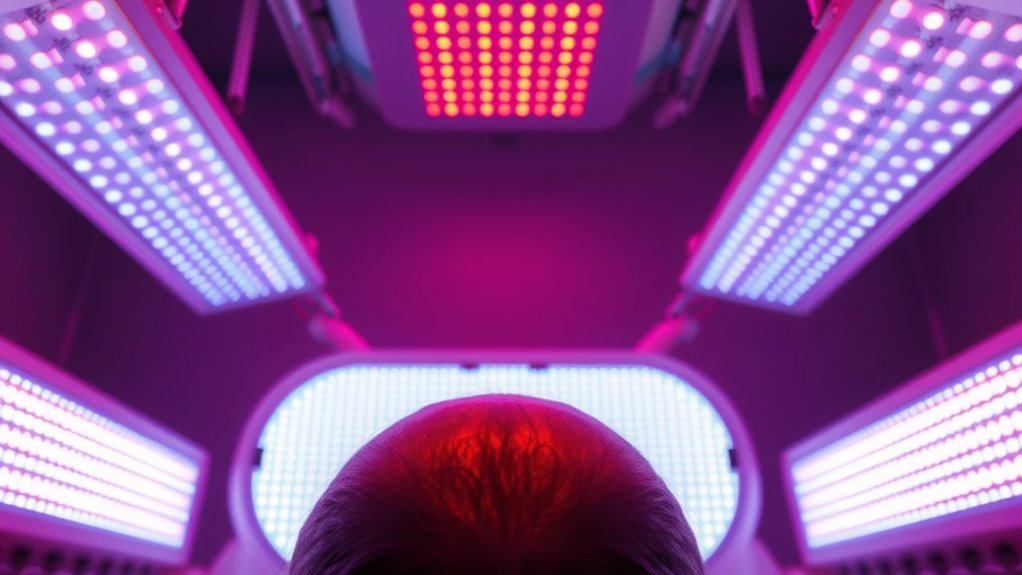
Light therapy has gained popularity as a non-invasive treatment option for hair growth, offering a promising alternative for those experiencing thinning or hair loss. Recent studies highlight how phototherapy benefits your scalp by stimulating hair follicles, improving circulation, and encouraging new growth. This innovative approach leverages specific wavelengths of light, typically red or near-infrared, to penetrate the scalp and activate cellular processes that promote healthier hair. As you explore this treatment, understanding the different scalp treatment techniques becomes essential, as they can vary in complexity and intensity, but all aim to deliver ideal light exposure to targeted areas.
Light therapy stimulates hair follicles and promotes growth through targeted, non-invasive light exposure.
When you opt for light therapy, you fundamentally harness the power of phototherapy benefits to boost your scalp’s health. The process involves exposing your scalp to low-level laser or LED light, which invigorates dormant hair follicles. This stimulation can increase blood flow to the scalp, delivering necessary nutrients and oxygen that are critical for hair growth. Scientific evidence shows that this enhanced circulation can revitalize hair follicles weakened by factors like genetics, stress, or hormonal imbalances. The non-invasive nature of these treatments makes them appealing, as you can incorporate them into your routine without significant downtime or discomfort. Understanding the science behind phototherapy can help you appreciate how these treatments work at a cellular level for better results.
Different scalp treatment techniques are tailored to suit your specific needs. Some clinics use handheld laser devices that you can use at home or during professional sessions. Others employ larger, stationary setups in clinics that cover more extensive scalp areas in a single session. Regardless of the method, the goal remains the same: to deliver consistent, targeted light exposure that stimulates cellular activity within hair follicles. The frequency and duration of treatments vary depending on your hair loss severity and response, but many users report noticeable improvements after several weeks of consistent use.
Additionally, these techniques often combine light therapy with other scalp treatments, such as topical medications or microneedling, to enhance results. This integrated approach can further promote hair follicle regeneration and strengthen existing hair strands. As ongoing research continues to shed light on the mechanisms behind phototherapy benefits, more precise protocols are emerging, making these treatments more effective and accessible. If you’re considering this route, understanding the different scalp treatment techniques helps you choose the most suitable option for your situation, ensuring you receive the maximum benefit from your light therapy sessions. Overall, the combination of scientific advancements and practical application makes light therapy a promising avenue for stimulating natural hair growth and restoring confidence.
Frequently Asked Questions
Can Light Therapy Reverse Advanced Hair Loss?
You might wonder if light therapy can reverse advanced hair loss. The phototherapy benefits include stimulating hair follicles and improving blood flow, which can enhance hair regrowth potential. While it shows promise, especially for early to moderate hair thinning, it may not fully reverse advanced loss. Consistent treatment, combined with other options, can offer improvements, but individual results vary. Always consult a specialist to understand the best approach for your situation.
How Long Does It Take to See Results?
Think of your hair growth journey as planting a seed; patience is key. Typically, you’ll notice visible improvements within 8 to 16 weeks of consistent light therapy. The treatment timeline varies for each person, but steady progress often appears like the first buds breaking through soil. Keep at it, and your hair’s revival will unfold gradually, revealing the fuller, healthier look you’re aiming for.
Is Light Therapy Safe for All Skin Types?
You might wonder if light therapy is safe for all skin types. Generally, it’s considered safe, but skin compatibility varies. Some skin types may respond better, and treatment customization helps minimize risks. It’s essential to consult a professional who can tailor the therapy to your skin’s specific needs. This personalized approach guarantees safe, effective results while reducing potential side effects, making light therapy suitable for most skin types.
Does Light Therapy Work for Both Men and Women?
You’ll be pleased to know that light therapy works for both men and women, though gender-specific treatments may be tailored to address hormonal influences unique to each. These treatments can effectively stimulate hair growth regardless of gender, as light therapy targets hair follicles directly. By customizing approaches based on gender, practitioners optimize results, making this a versatile option for anyone experiencing hair loss.
Are There Any Side Effects From Long-Term Use?
You might wonder about long-term light therapy effects, and it’s good to be cautious. While most users experience no serious issues, some report skin pigmentation changes or photosensitivity reactions. These side effects are rare and often linked to excessive or improper use. To protect yourself, follow recommended guidelines, consult a professional, and monitor your skin’s response. With proper use, you can enjoy benefits while minimizing potential risks.
Conclusion
Think of light therapy as a gentle gardener tending your hair’s garden. With each session, it nurtures dormant follicles, encouraging new growth to sprout and flourish. Just like sunlight awakens a sleepy garden, light therapy awakens your hair’s potential. Embrace this innovative treatment as your personal sunshine, guiding your hair back to fullness and vigor. Soon, you’ll see your hair bloom again, thriving under the warm, revitalizing glow of modern science.
